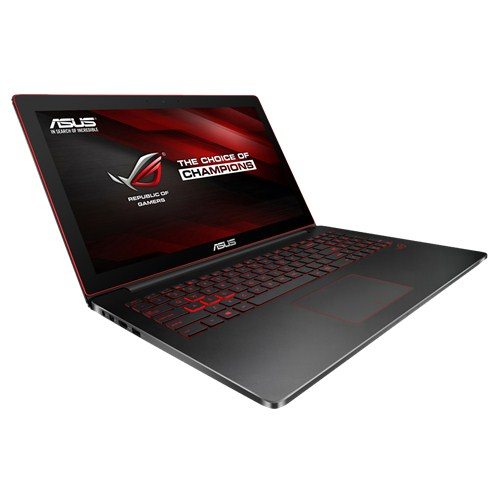Specs
Republic of Gamers—or ROG—machines are designed with gaming in mind as the name implies. To that end this laptop has impressive hardware specs. In fact, the specs of the Asus ROG G501 laptop rival or exceed many desktop gaming machines.
Asus packs a 3.6GHz 4th-generation Intel Core i7 processor and 16GB of RAM plus 512GB of SSD storage into the laptop. It also has an NVIDIA GeForce GTX 960M graphics with 4GB of dedicated VRAM. The laptop has an audio jack, three USB 3.0 ports, and HDMI, Thunderbolt and power adapter ports. There’s also a 2-in-1 SD / MMC card reader and microSD card slot.
The ROG G501 is 15.1 inches by 10.0 inches and a mere 0.8 inches thick. It weighs in at just 4.5 pounds.
Form
What’s more amazing than the hardware specs themselves is the fact that Asus packed all of that computing and gaming horsepower into an ultrathin machine.
The ROG G501 weighs almost twice as much as my primary computer—the Surface Pro 3—even after I add the weight of the Type keyboard cover and Surface Pen. The Surface Pro 3 also packs a lot of desktop-equivalent computing power into a ridiculously small package, but in the ROG G501’s defense the Surface Pro 3 doesn’t come close to the computing and gaming horsepower Asus has crammed into this thing. In other words, 4.5 pounds isn’t the lightest laptop you can get but it may be the lightest you can get that has this much computing power.
One thing conspicuously missing from all of the ports and connections is an Ethernet port. Asus had to sacrifice the Ethernet connection to keep the ROG G501 slim. Asus knows how important a wired Ethernet connection is—especially for stable gaming and video streaming—so it includes a USB-to-Ethernet dongle with the laptop.
Function
It boots up almost before you can blink. It ran every program we threw at it with exceptional performance. Then we moved onto games. I enlisted the support of the junior TechSpective staff (AKA my teen boys who spend most of their days engaged in some form of gaming via Steam) to test out its gaming prowess and they were stunned. They both have fairly robust gaming desktops, but the ROG G501 actually has better specs in almost every way.
The backlit keyboard is solid and the keys have a fair amount of travel so you actually feel like you’re typing. The WASD keys commonly used as directional navigation in games are specifically highlighted.
One of the things that makes the ROG G501 so blazingly fast is that the SSD storage is PCIe x4 rather than SATA III. According to Asus the SSD storage in the ROG G501 performs more than twice as well as traditional SATA III SSDs.
The15.6-inch 4K / UHD display has a resolution of 3840 x 2160—that’s 8.2 million pixels. In theory the 4K resolution will deliver sharper more vibrant images. So far, though, I haven’t found much real-world use of 4K. It’s still in the novelty phase while we wait for the content and games to arrive that can make proper use of it.
Verdict
Lately it seems like Asus is the brand to beat when it comes to getting exceptional computing hardware at reasonable prices. The ROG G501 isn’t cheap by laptop standards, but considering the hardware Asus has packed into this svelte package the $1,590.00 price tag is quite reasonable.
The 4K display is ahead of its time—as most 4K technology is right now. It sounds impressive, but there just isn’t much practical use for it just yet. Asus provides almost all of the ports and connections you could want on the ROG G501 and the notable exception—the Ethernet port—is still delivered via the included USB dongle.
If you just want an ultrabook capable of running Windows and all of your Windows applications you should look at the Asus Zenbook UX305 for about half the money. If you want all of the horsepower of a desktop and then some in a thin, light portable machine that can blow the doors off of many dedicated gaming machines then you should definitely take a look at the Asus Republic of Gaming G501.



